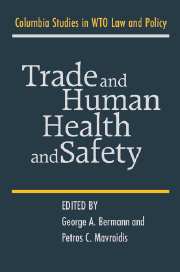Book contents
- Frontmatter
- Contents
- Preface to the Series
- Introductory Remarks
- 1 A Map of the World Trade Organization Law of Domestic Regulation of Goods
- 2 The WTO Impact on Internal Regulations: A Case Study of the Canada–EC Asbestos Dispute
- 3 Reflections on the Appellate Body Decision in the Hormones Case and the Meaning of the SPS Agreement
- 4 The Salmon Case: Evolution of Balancing Mechanisms for Non-Trade Values in WTO
- 5 Lotus Eaters: Reflections on the Varietals Dispute, the SPS Agreement and WTO Dispute Resolution
- 6 Regulatory Purpose and “Like Products” in Article III:4 of the GATT (with Additional Remarks on Article III:2)
- 7 The WTO Standard of Review in Health and Safety Disputes
- 8 Expert Advice in WTO Dispute Settlement
- 9 Domestic Regulation, Sovereignty and Scientific Evidence Requirements: A Pessimistic View
- 10 Time for a United Nations' “Global Compact” for Integrating Human Rights into the Law of Worldwide Organizations: Lessons from European Integration Law for Global Integration Law
- Index
4 - The Salmon Case: Evolution of Balancing Mechanisms for Non-Trade Values in WTO
Published online by Cambridge University Press: 27 July 2009
- Frontmatter
- Contents
- Preface to the Series
- Introductory Remarks
- 1 A Map of the World Trade Organization Law of Domestic Regulation of Goods
- 2 The WTO Impact on Internal Regulations: A Case Study of the Canada–EC Asbestos Dispute
- 3 Reflections on the Appellate Body Decision in the Hormones Case and the Meaning of the SPS Agreement
- 4 The Salmon Case: Evolution of Balancing Mechanisms for Non-Trade Values in WTO
- 5 Lotus Eaters: Reflections on the Varietals Dispute, the SPS Agreement and WTO Dispute Resolution
- 6 Regulatory Purpose and “Like Products” in Article III:4 of the GATT (with Additional Remarks on Article III:2)
- 7 The WTO Standard of Review in Health and Safety Disputes
- 8 Expert Advice in WTO Dispute Settlement
- 9 Domestic Regulation, Sovereignty and Scientific Evidence Requirements: A Pessimistic View
- 10 Time for a United Nations' “Global Compact” for Integrating Human Rights into the Law of Worldwide Organizations: Lessons from European Integration Law for Global Integration Law
- Index
Summary
Introduction
The Salmon case represents an important step in the evolution of the doctrinal tools available for managing WTO disputes involving non-trade values. Joel Trachtman has termed these doctrinal tools “trade-off devices,” used to guide WTO dispute settlement bodies as to how to balance and weigh the trade versus non-trade values embodied in the particular measure, and GATT/WTO provisions, at stake in a given dispute. Although the Salmon case concerns the specialized WTO Agreement on the Application of Sanitary and Phytosanitary Measures (SPS Agreement), it has implications for the broader development of WTO jurisprudence with respect to the place of non-trade values in the WTO regime.
The SPS Agreement sets out a road map for Members seeking to enact GATT-consistent measures addressing sanitary and phytosanitary concerns. In SPS matters, the non-trade value at stake is the protection of human, animal or plant (HAP) life or health from risks borne by imported products. The trade value at stake is the free movement of goods, because SPS measures have as their effect the prohibition or conditional entry of products deemed by the Member to pose a threat to HAP life or health.
The SPS Agreement protects Members' right to adopt necessary SPS measures (Article 2.1), but only if the SPS measure “is applied only to the extent necessary to protect human, animal or plant life or health, is based on scientific principles, and is not maintained without sufficient scientific evidence” (Article 2.2).
- Type
- Chapter
- Information
- Trade and Human Health and Safety , pp. 133 - 152Publisher: Cambridge University PressPrint publication year: 2006
- 3
- Cited by



